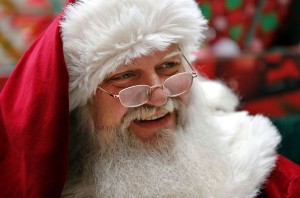
ALBUQUERQUE, New Mexico – In Atlanta, children of many races share their Christmas wish lists with a black Santa Claus.
In Houston, Santa dons a red zoot suit and dances to jazz as he hands out gifts in Mexican-American neighborhoods.
In Indian Country, Native American Santas add American Indian attire to their red snowsuits, visiting shops and community centers from the pueblos of New Mexico to the reservations on the Pacific Northwest.
Santa Claus may be popularly known as a white-bearded benefactor with Dutch-English origins, but multiethnic versions of Santa are making the rounds out there too — illustrating that in an increasingly diverse United States, Santa takes on whatever color you imagine him to be.
“Kids don’t see color. They see a fat guy in a red suit giving toys,” said Dee Sinclair, 50, of Atlanta, who bills himself as the “Real Black Santa” and sports a very real, very white beard to prove it. He said in his 12 years of Santa-dom, he has posed with children and adults of all backgrounds during appearances at art centers, private parties and the occasional suburban Christmas tree lighting.
This holiday season, however, not all reactions to non-white Santas have been jolly.
Last week, a high school teacher in Rio Rancho, New Mexico, was disciplined, and apologized, for telling a black student who dressed as Santa Claus, “Don’t you know Santa Claus is white? Why are you wearing that?” The teacher has since been placed on paid administrative leave.
Also last week, Fox News host Megyn Kelly sparked a heated debate when she declared on air, “And by the way, for all you kids watching at home, Santa just is white,” during a panel discussion about a blogger’s essay arguing that children of other races could feel alienated by constantly seeing Santa as white. Kelly later said her comments were motivated by humor, not “by any racial fear or loathing.”
That situation was promptly skewered by comics such as Comedy Central’s Jon Stewart and Kenan Thompson of NBC’s Saturday Night Live, who, clad in a full Santa suit and beard, joked about Kelly’s comments and quipped: “You heard of secret Santa? Well, here’s a secret for you: I’m black as hell!”
Richard Reyes, 62, of Houston, who has portrayed “Pancho Claus” for 32 years, found this year’s debate over Santa’s race surprising. He has seen Santa transformed into many images for years, he said; In his version, Pancho Claus has a goatee, and accessorizes his zoot suit with sunglasses and a fedora.
“For these diverse times, it’s important for children to see Santa in all these different forms,” Reyes said.
Andrew Chesnut, the Bishop Walter F. Sullivan Chair in Catholic Studies at Virginia Commonwealth University, said depictions of Santa Claus as a white man came about mainly because he was a European import, a blend of the Dutch Sinterklaas and British folklore character Father Christmas, with elements of Saint Nicholas, a 4th-century Greek bishop in modern-day Turkey.
“But there is no reason he can’t be portrayed as black or Latino,” Chesnut said. “We live in the most pluralist, diverse society on earth and this is going to happen.”
Chesnut compared Santa’s evolution to that of La Virgen de Guadalupe, the patron saint of Mexico. That image came from a black Virgin Mary from Spain who transformed into an indigenous icon in the Americas to relate to the population, he said.
Baldwin Hills Crenshaw Plaza, a mall in the center of black Los Angeles, has operated a diversity Santa program for more than 10 years, where two Santas — one black, one Latino — share time taking photos with families. “It’s been great,” said Rachel Erickson, the mall’s marketing director. “The Santas have developed relationships with families and they come back year after year.”
“(Santa Claus) reflects whatever region he resides. He belongs to everyone,” said Xavier Garza, author of “Charro Claus and the Tejas Kid,” a bilingual children’s book based on Santa Claus’ “Mexican cousin” along the Texas-Mexico border.
In Garza’s book, Charro Claus refuses to let “rain, wind or border fences” prevent him from delivering toys to kids in the Texas Rio Grande Valley. Magic dust transforms an old mariachi outfit into a gold-and-silver sequined marvel and old burros into lucha libre-masked Flying Burritos to help Charro Claus deliver toys.
The short film and book “The Native American Night Before Christmas” by Gary Robinson has “Old Red Shirt,” or the American Indian Santa Claus, visiting children with a team of flying white buffalo to deliver commodities, fry bread and other goodies.
“As with Jesus, cultures adopt images that apply to them,” said Robinson, who lives on the Santa Ynez Reservation in California. “So it’s totally appropriate that we do it with Santa.”